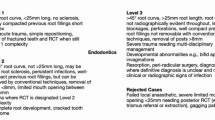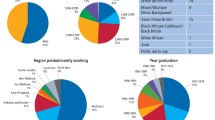Key Points
-
The survey results presented should contribute to improved communication between GDPs and Hospital Specialists.
-
The results confirmed good practice in some aspects of communication in this hospital and identified areas of potential improvement.
-
The results can be used as the basis for audit in other parts of the UK.
Abstract
Objectives To discover what dentists require of a hospital response letter with regards to content and timeliness.
Design Postal survey.
Setting South Wales.
Subjects and methods A postal questionnaire was issued to all dentists (n = 256) who had referred a patient to the dental hospital between 1 January 2003 and 1 March 2003.
Results The response rate was 60.2% (154). The preferred time frame for the receipt of a letter following a patient's appointment was one to three weeks for 96.4% (n = 133) of respondents, but 58.4% believed that they currently do not receive responses within this time frame. The preferred method of communication remained the letter (n = 82, 53%), followed by the telephone (n = 58, 38%). E-mail accounted for eight percent (n = 12) of communication. Most respondents (70%, n = 107) were satisfied with the letters' content. Eight of the ten items of information suggested as being appropriate in a response letter were considered essential by 53.2% of dentists (n = 82), and 55.8% (n = 76) believed the remaining two items to be desirable.
Conclusions Dentists agree closely on the information required in a response letter and most are satisfied with the content of current response letters. However, many dentists believe response letters arrive later than three weeks after their patient's appointment.
Similar content being viewed by others
Introduction
Good communication is an important means of improving patient care and developing inter-professional relationships.1 It has been suggested that response letters serve to educate general dental practitioners on the provision of appropriate treatment to patients,1 thus reducing the number of future referrals with similar presentation. The standard of referral letters from general dental practitioners to specialists in the hospital dental services has been evaluated.2 However, few studies have focussed on the standard of response letters from the hospital dental services, except for a limited number examining a specific monospecialty such as Oral Medicine,3 Orthodontics4,5 and Restorative Dentistry.6
In this study, general dental practitioners, as the recipients of response letters, were invited to assess various aspects of the response letters they received following a patient's first hospital appointment.
The aims of the survey were to discover:
-
The timescale acceptable to dentists for the receipt of a letter following a referred patient's first appointment, and to determine whether or not the letters arrived within that time
-
The information required by general dental practitioners following the referred patient's first appointment, and
-
Whether or not general dental practitioners required more information in the response letters they were receiving.
Method
A questionnaire, having closed questions with single-response tick-box options, was designed. It also invited open comments addressed to all or specified hospital departments.
Before distribution, the questionnaire was piloted on a number of general dental practitioners excluded from the sample; comments were received and amendments made.
Permission to conduct the survey was obtained from the Hospital Dental Services' Clinical Director and the Dental Hospital Clinical Audit Committee.
The study population comprised the referring dentists of all patients who attended Cardiff University Dental Hospital and for whom a response letter was issued between January 1st 2003 and March 1st 2003.
The 256 GDPs were sent a copy of the questionnaire and a pre-paid response envelope; each envelope being given a unique identification number to facilitate follow-up of non-respondents and to prevent multiple responses. A response period of three weeks was set. Once received, responses were separated from their envelopes and treated anonymously.
Results
The response rate for the survey was 60.2% (n = 154).
The results showed that most dentists in the sample referred patients to the University Dental Hospital (UDH) between one and four times in a three-month period, with 4.5% of dentists referring none and the same proportion referring 20 or more (Table 1).
At UDH, the departments most commonly referred to were Oral Medicine (73%) and Oral Surgery (68%), followed by the Periodontal department (61%) (Table 2).
One hundred and thirty-three dentists (96.4%) expected to receive a response letter within between one and three weeks of their patient's first appointment (Table 3). However, 90 (58.4%) of the respondents believed that they do not receive letters within this time. The majority were satisfied with the content of the letters (n = 107, 70%) and felt welcome to discuss a proposed treatment plan with the consultant (n = 92, 60%) ( Table 4).
The preferred method of communication remained the letter (n = 82, 53%), followed by the telephone (n = 58, 38%). An e-mail preference accounted for 8% (n = 12) of the communication methods (Table 5).
More than half (n = 82, 53.2%) of the dentists believed eight of the ten items of information suggested as being appropriate to a response letter to be essential, with again more than half (n = 76, 55.8%) believing the remaining two items to be desirable (Table 6).
Twenty-five (16%) dentists expressed a preference for further items of information to be contained in a response letter (Table 4). However, 33 (21%) of the respondents provided comments related to all or specified departments. The most common request (n = 9, 27%) concerned information relating to waiting lists, followed by requests for acknowledgement of receipt of referral letter (n = 7, 21%) (Table 7).
Discussion
The survey was conducted during the first three weeks of March, when most dentists had returned from any mid-winter break, to maximise the number of possible respondents and to, hopefully, negate the effects of holidays on the response rate.
There is marked variation in the numbers of patients referred to the hospital by each general dental practitioner in the survey − between 0 and 20+ per three-month period. It is possible that some dentists replied on behalf of their practice or do indeed have such a high referral rate.
The high numbers of referrals to the departments of Oral Surgery and Oral Medicine are reflected in the number of comments made under these headings – particularly for Oral Surgery. Conversely, the departments Accident and Emergency and Orthodontics received far fewer comments and the only department which was not specifically mentioned by any respondent was Prosthetics, which may be linked to the lower number of referrals.
The greatest number of comments related to waiting list time information, a similar finding to that of Noble in 1994,4 in a survey of dentists' opinions of consultant orthodontist response letters. Noble4 also noted that dentists would like easier telephone access to consultants, which is also reflected in the results of this survey.
The number of GDPs who are satisfied with the content of the response letters (70%) corresponds with the findings of Noble,4 where 72% were satisfied, but a greater number requested further information (21%) than in this survey (16%). In a study by Lamey et al.,3 barely half of GDPs considered a diagnosis essential in a response letter, compared to 94% in this study. This may be due to changing attitudes from both practitioners and patients in the intervening 16 years.
In a study conducted in 1995, Salathia and McIlwaine7 found that 79% of general medical practitioners preferred a structured letter with headings to ensure the comprehensiveness of the response. These findings agreed with those of Rawal et al.8 in 1993, and Lamey et al.3 suggested a similar approach for response letters from the dental specialties. However, the findings of this survey suggest that the majority of dentists (70%) receive all the information that they require from existing response letters. It might appear unnecessarily antagonistic to demand changes to the format of the letters when the additional information required by most practitioners concerns waiting times and acknowledgement rather than clinical issues. Much of the information requested by the GDPs could be provided in a departmental information sheet, rather like a practice information leaflet.
Whilst the GDPs generally felt welcome to contact a specialist, preferably by letter, the comments show that they experienced difficulties when trying to speak to consultants by telephone.
The low number of dentists who would prefer to e-mail consultants may be due to the absence of a secure connection for sending patient information. It may also reflect a lack of IT skills and equipment amongst practitioners, many of whom have computers but use them for administrative purposes only and are not online. The questionnaire did not enquire about the dentists' age, but this may have had an impact on the number interested in using e-mail. An advantage of this form of communication is the automatic acknowledgement of the referral.
The number of requests for waiting time information and acknowledgement of referral letters may reflect the concerns of some dentists that patients are lost to care when the dentist is under the misconception that the patient is attending the hospital.
The comments suggest that there may be a delay of as much as two weeks between the dictation of the letter and its receipt by the dentist. Unless the letter is dictated immediately after the appointment it is unlikely to arrive within the three weeks acceptable to 45.5% of GDPs and cannot arrive within the two weeks expected by 40.9%.
Conclusion
Within the group studied, general dental practitioners are in close agreement as to the information which should be present in a response letter following their patient's first hospital appointment. They feel welcome to write to hospital specialists regarding their patients and are satisfied with the content of the response letters that they receive. However, although most dentists would prefer a response letter to arrive within three weeks of their patient's first appointment, many believe that the arrival date currently exceeds this time limit. The extra information most commonly requested by dentists relates to waiting times and acknowledgement of their referral letter.
References
Craven R, Fleming P. Referral to hospital: improving communication between the dental practitioner and hospital dental staff. Dent Update 1992; December: 438– 439.
McAndrew R, Potts A J C, McAndrew M, Adam S. Opinions of dental consultants on the standard of referral letters in dentistry. Br Dent J 1997; 182: 22– 25.
Lamey P-J, Samaranayake L P, Glass G W J. Communication between a specialist dental hospital department and referring general dental practitioners: an attempt at clinical audit. Community Dent Oral Epidemiol 1987; 15: 277– 278.
Noble P . Audit in orthodontic practice: how well do we communicate with our referring practitioners? Br J Orthodontics 1994; 21: 321– 326.
Hammond M, Evans D R, Rock W P . A study of letters between general dental practitioners and consultant orthodontists. Br Dent J 1996; 180: 259– 263.
Ricketts D N J, Scott B J J, Chadwick R G et al. Peer review amongst restorative specialists on the quality of their communication with referring dental practitioners. Br Dent J 2003; 195: 389– 393.
Salathia K, McIlwaine W J . General practitioner and hospital letters. Ulster Medical Journal 1995; 64: 46– 50.
Rawal J, Barnett P, Lloyd B W . Use of structured letters to improve communication between hospital doctors and general practitioners. Br Med J 1993; 307: 1044.
Author information
Authors and Affiliations
Corresponding author
Additional information
Refereed paper
Rights and permissions
About this article
Cite this article
Tomlinson, P., McAndrew, R. A survey of general dental practitioners' opinions of response letters received from hospital specialists following a referred patient's first appointment. Br Dent J 200, 621–623 (2006). https://doi.org/10.1038/sj.bdj.4813641
Accepted:
Published:
Issue Date:
DOI: https://doi.org/10.1038/sj.bdj.4813641
This article is cited by
-
Oral neglect as a marker of broader neglect: a cross-sectional investigation of orodental consultation letter of leukemic admitted patients in Iran
BMC Oral Health (2021)
-
GDPs' opinions of responses from specialists after a referral
British Dental Journal (2006)



